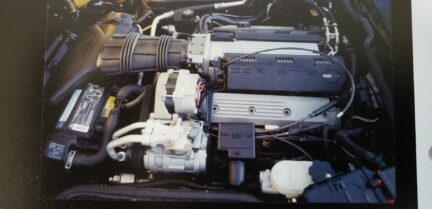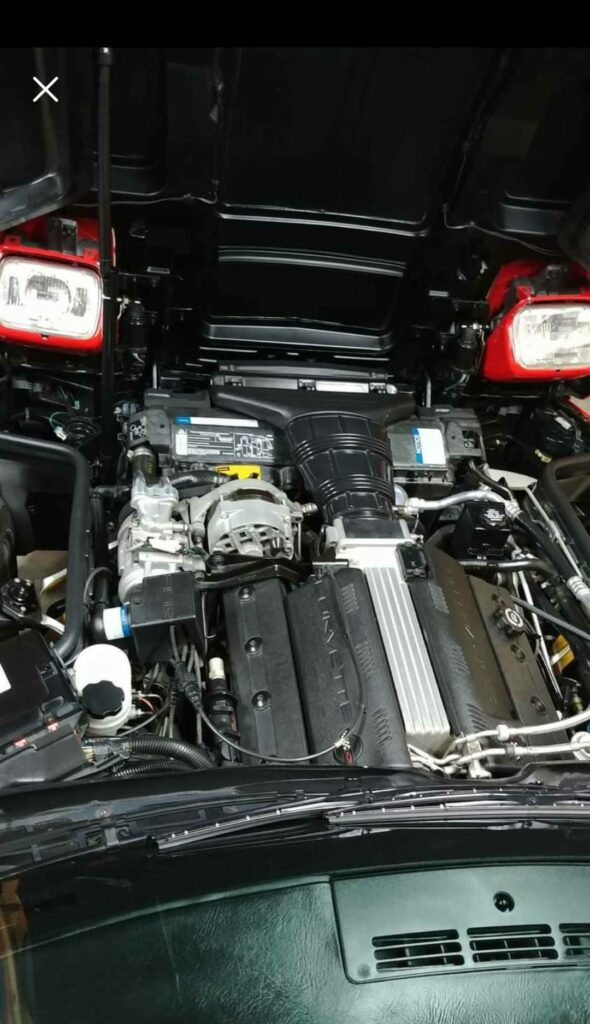
After seven years of the L98 TPI engine in the C4 Corvette, a new engine became standard in the 1992 C4 Corvette. GM introduced the LT1 generation II engine. The LT1 (no hyphen) was a tribute to and named after the original LT-1 (with a hyphen) high compression solid lifter engines from the early 1970’s.
1992-1993 C4 LT1 Corvette
The new LT1 C4 Corvette for 1992 was rated at 300 horsepower and 330 pound feet of torque. Chevrolet claimed 0-60 in less than five seconds. There were significant differences between the new engine and the L98 engine from previous C4 Corvettes and earlier small blocks. The water pump, timing cover, block, heads, intake manifold as well as the accessories brackets are not interchangeable with prior small block engines. Things carried over from prior years are the engine mount locations and the bell housing are the same. There are slight differences between the early and later heads.
The LT1 is a cast iron block. It has 2 valves per cylinder (16 total) and are made from aluminum. Electronic fuel injection supplies the engine and has a 48-mm throttle body. The intake manifold is aluminum as well.
The LT1 is reverse flow cooled which means the coolant flows through the heads first and then the engine block. Normally coolant flows the opposite direction. Because of the reverse flow the engine dies not need a special radiator but an overflow tank is necessary to keep air out of the system. Also, new for the LT1 was the Opti-spark which helped to increase performance over the L98’s before it. Unfortunately this new improvement over the previous distributor setups was often an issue for LT1 owners and one of the engines few weak spots.
1993 a new camshaft was added that pushed the LT1 to 340 pound feet of torque.
GM also started putting the LT1 in some of their other models. Although the F- bodies (Camero and Firebird) got the Lt1 in 1993, these models only got 2 bolt mains. The Corvette got the 4 bolt main and aluminum heads. The F-bodys had only 275 horsepower and 325 pound feet of torque. Still, nothing to sneeze at the Camero and Firebirds were great performance buys at the time.
1994 LT1 C4 Corvette
New for 1994 was a mass airflow sensor that works with the carryover map sensor. Sequential Port Injection was added in 1994 with a new computer. The new computer has a PROM that is not removable but can be programmed for better performance.
In 1994 GM also added the LT1 to some of their other vehicles, the B and D body sedans. These included The Buick Roadmaster, Cadillac Fleetwood, Chevy Caprice along with police cars and the Impala SS. They got the LT1 with 2 bolt mains and cast iron heads. These were all rated at 265 horsepower. The Impala is still a highly sought after vehicle because of the LT1 even today.

The LT1 was also available in the 4.3L which is very similar to the 5.7L 350 V8.
1995 LT1 C4 Corvette
A new distributor electrical connection appears in 1995 and it is not compatible with the harnesses from the earlier C4 Corvettes. The distributor drive was enlarged as well and will not work with earlier C4’s either. A drain tube was added to the distributor to help remove condensation build up.
1996 LT1/LT4 C4 Corvette
1996 was the end of an era. Not only is it the last year of the C4 Corvette it is also the last year of the LT1. An LT4 was also introduced in 1996 as an option only available in the C4 Corvette and was rated at 330 horsepower and 340 pound feet of torque. Road and Track magazine tested the LT4 and recorded 0-60 in 5.2 seconds and a quarter mile time of 13.7 seconds at 105.1 mph.
Conclusion
The LT1 engine had a great run during the 1990s. Not only did it push the C4 Corvette back over 300 horsepower since the early 1970s, it brought the performance and quickness back to the top of the automotive world. Just like the introduction of the L98, the LT1 was a stepping stone to the later LS engines that are popular today used in all kind of automotive applications.
For a table of all C4 Corvette engines and performance numbers on a sortable table, check out my page here.